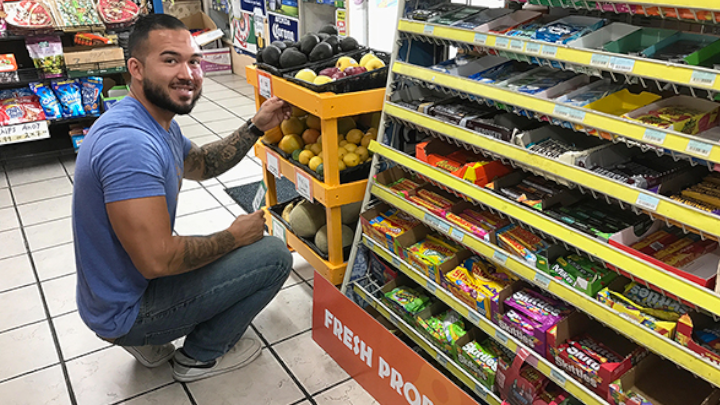Student-led nonprofit increased access to fresh produce for South Bay residents
The study, published in the Journal of Public Policy and Marketing, looked at BrightSide Produce’s effectiveness over the past five years in improving access to fresh produce for those living in National City, a known food desert.

Tens of thousands of residents in National City now live within a quarter-mile, or a 10-minute walk, of stores selling fresh produce, according to a new study which examines the impact of BrightSide Produce, a San Diego State University student-led non-profit.
The organization, founded in 2017, works to bring fresh fruits and vegetables to the shelves of small corner convenience, and liquor stores in communities that have less access to grocery stores and fresh food items.
The study, led by researchers at SDSU and the University of Oklahoma and recently published in the Journal of Public Policy and Marketing, looked at BrightSide Produce’s effectiveness over the past five years in improving access to fresh produce for those living in National City, a known food desert.
Launched by Iana Castro, a SDSU marketing professor in the Fowler College of Business and one of the study’s lead researchers, the non-profit aims to increase healthy food access in underserved communities through produce distribution to local food retailers.
As part of the study, Castro and a team of researchers studied National City residents’ access to retailers with fresh produce, both before and after the introduction of BrightSide’s distribution services to 13 partner stores. They relied on systematic web searches to identify the location of supermarkets, existing transit service data from the San Diego Association of Governments (SANDAG), as well as data from the U.S. Census Bureau. They then mapped out the locations of the stores, along with existing grocery stores that also stocked produce, and then calculated the travel time between residents and the stores.
“Our results suggest that BrightSide Produce reduced the spatial inequality in healthy food access in National City in multiple ways,” said Castro.
“First, the importance of liquor, corner and convenience stores and small markets became undeniable as they were transformed into reliable sources of affordable produce,” Castro continued. “Second, more community residents are now within walking or public transportation distance from a store offering fresh fruits and vegetables, allowing a significant proportion of residents to gain access to stores that sell produce. Finally, the introduction of BrightSide’s services to partner stores allowed National City to meet stated priorities and policy goals that had previously gone unaddressed.”
Significantly increased access to fresh foods
The researchers found that the addition of the 13 BrightSide partner stores more than doubled the number of residential areas located within a quarter mile of a fresh produce retailer, and reduced public transit travel times to a fresh produce retailer for an estimated 34,038 people – over half of National City’s residents.
When it first launched, the organization delivered produce from local wholesalers to five stores in National City. Today, student interns distribute fresh fruits and vegetables to 29 small stores on a weekly basis. As of February 2024, BrightSide Produce has delivered an estimated 500,000 units of produce to its partner stores, which have the potential to reach 134,000 residents in the communities served.
“It is both inspiring and remarkable what SDSU’s BrightSide Produce, operated by SDSU undergraduate and graduate students, has been able to accomplish in expanding access to fresh produce for thousands of National City residents,” said Assemblymember David Alvarez.
“The community impact is immeasurable and the study is tangible proof of the impact of combining passion for change, ingenuity and skill set,” Alvarez said. “I hope the organization’s model can be replicated in other communities in San Diego, and across the country.”
A growth model, driven by collaboration
With the organization's growth, the team has made creative shifts to their distribution model.
In the last two years, they began working with local farmers directly, harvesting their own produce to offset rising produce costs, and, knowing that how much customers can afford to pay for each item has not changed, they began utilizing grants from the United States Department of Agriculture and the San Diego Foundation.
“This approach offers local farmers the opportunity to reach San Diego County residents through our network of store partners,” Castro explained. “Our partnerships with the farms provide BrightSide customers with fresh-from-the-farm produce and provide farmers with an additional stream of revenue.”
With a zero waste goal, BrightSide donates all edible produce that was not sold to a local community center. Any spoiled produce is composted by a local organization.
Castro said more than 200 students have participated in BrightSide Produce’s internship program.
“Many of the students involved with BrightSide Produce come to us with an interest in social justice, social entrepreneurship, or food access challenges,“ Castro said. “Students who intern with BrightSide get an in-depth look at the social challenges confronting underserved communities and become part of a creative solution designed to address some of those challenges.”
Brightside Produce’s expansion was made possible, in part, through funding provided by the United States Department of Agriculture, San Diego Foundation and San Diego County CalFresh Healthy Living Program.



